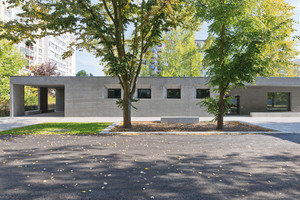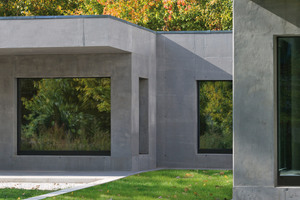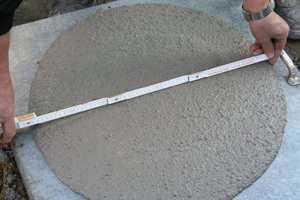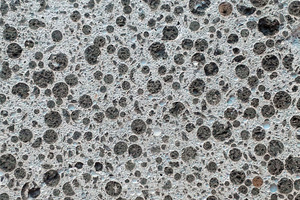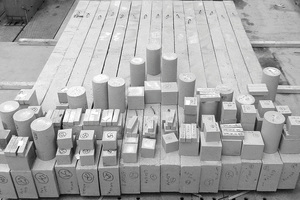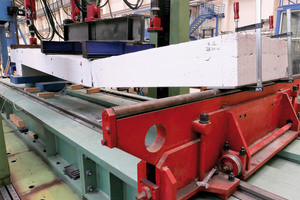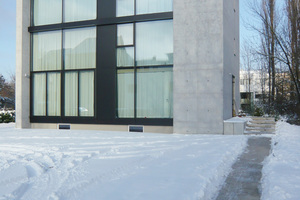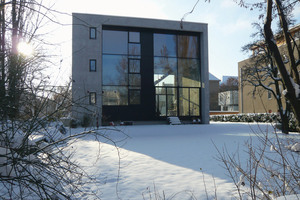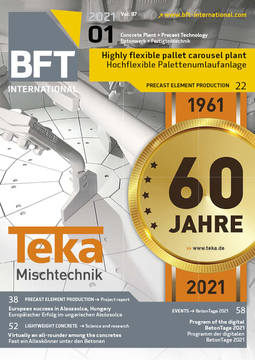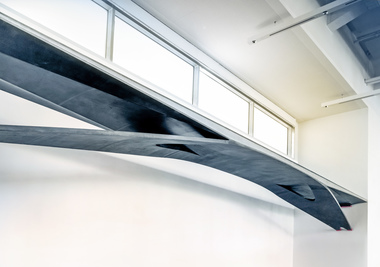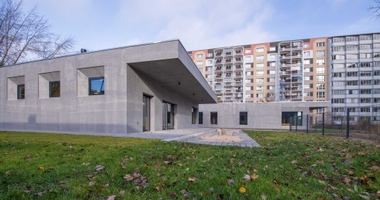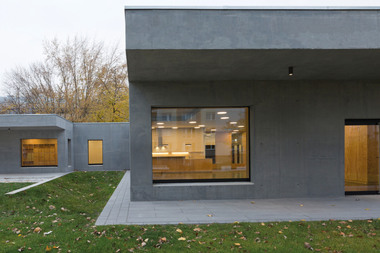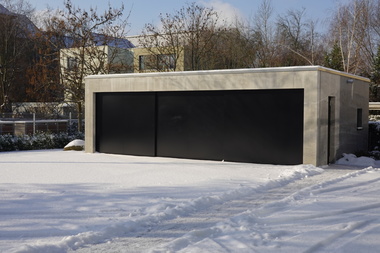Virtually an all-rounder among the concretes
Research on infra-lightweight concrete as a monolithic and thermal-insulating construction material is conducted at the Chair of Conceptual and Structural Design at Technische Hochschule Berlin headed by Prof. Dr. Mike Schlaich. He and Dr. Alexander Hückler will present current findings of the research activities, among others, at the upcoming BetonTage congress held in Ulm.
Generally, concrete is regarded as a heavy, solid, load-bearing and impermeable material. Infra-lightweight concrete, which etymologically derives from the Latin adverb infra = below/beneath, combines a range of properties and applications which are a novelty in respect
of the construction material concrete. Due to the reduction
of its specific weight to below 800 kg/m³, infra-lightweight concrete is one of the extremely light and structurally
dense concretes, summarized under the general term of lightweight concrete. Infra-lightweight concrete even undercuts the well-known characteristics and values of lightweight concrete thanks to its very low apparent density. It is not only lighter than water – therefore floatable –, but is also provided with a thermal insulation
capacity, along with its structural qualities. It is, so to speak, an all-rounder combining the outstanding double function as a „load-bearing thermal insulation“ in times of continual energy optimization.
Infra-lightweight concrete makes construction easier
An increasingly confusing number of diverse construction materials, which have to be connected to each other, can be found on today‘s construction sites. From the perspective
of sustainability, this is rather unfavorable – measured
by the service life of building structures – becausetons of hazardous waste are caused when they are demolished at the latest. However, when the most diverse materials
are manufactured and delivered, and when they are installed in conformity with standards, there often already
is a Babylonian confusion. The present reference buildings using infra-lightweight concrete, in contrast, show an astonishing simplicity as far as the phases of production, processing, construction and life cycle of the materials and buildings in the Central European region are concerned.
When using infra-lightweight concrete, the need of complicated and elaborate façade structures is eliminated, for example. Load-bearing components must neither be provided with insulating material nor a weather protection
layer. The connections to balconies, windows and doors are just as simple. Thermal bridges are excluded right from the beginning. Thus, construction in a very sustain-able, energy-efficient and eco-friendly manner is possible
with infra-lightweight concrete in accordance with current regulations.
TU Berlin as research facility for infra-lightweight concrete
Since 2005, research on infra-lightweight concrete as a monolithic and thermal-insulating construction materials
has been conducted above all at the Chair of Conceptual and Structural Design at Technische Hochschule Berlin headed by Prof. Dr. Mike Schlaich [1]:
„Nowadays, infra-lightweight concrete achieves mean compressive strengths of up to flcm = 13 MPa accurately, which, in compliance with the conformity criteria, is corresponding to concrete LC8/9 and allows multi-story buildings. As part of a current project of TU Berlin, at present, an improved mix design with mean cube compressive strength of up to 18 MPa at a dry density of 800 kg/m³ is currently investigated with the aid of test walls. At the same time, it is possible to reach thermal conductivity values of between λ10,tr = 0.14 and 0.19 W/(mK) depending on the strength, thus complying with the German Energy Conservation Ordinance (EnEV) for buildings at a wall thickness of approx. 50 to 60 cm proved by the „building certificate“. Even more stringent requirements can be met by means of wall activation.“ [2]
Infra-lightweight concrete is made by replacing the usually heavy aggregates by lightweight ones of expanded clay, expanded glass, foam glass gravel, pumice and tuff. By the addition of concrete admixtures, a further reduction of the dry density can be achieved by the introduction of air into the hardened cement paste matrix. Despite an air void contents of > 20 %, infra-lightweight concrete features a closed surface.
In collaboration with, among others, HeidelbergCement, Sika Deutschland, Transsolar and Schlaich Bergermann Partner investigations are conducted on multi-functional
lightweight concrete elements (MultiLC) made of layers of various infra-lightweight concretes with universal properties. They are load-bearing, cooling, heating, are open to vapor diffusion and decompose pollutants: „It is part of the project to investigate layered structural components made of ILC800 (shell) and ILC600 (core). After successful preliminary tests on small- and medium-sized beams and walls (1:2) regarding the load-bearing behavior and the deformation behavior, 1:1 prototypes with functionally layered cross-sections were made in the precast concrete plant (Heidelberger Betonelemente Laußnitz) and were investigated in terms of building physics at TU Berlin. In a wet-on-wet production process, it was possible to achieve an adequate bond between
the layers so that delamination did not occur neither by shrinkage nor by external stresses which were applied in the preliminary tests. As a function of the acting temperature cycles of between - 20 °C and +50 °C, besides the durability, an „effective“ U-value, resulting from the wall activation, is experimentally determined with the aid of the test wall. For this purpose, water is flowing through capillary tube mats, which are embedded in concrete below the component surface, at flow temperatures of 5 °C, 10 °C and 15 °C. Then the „effective“ U-value expected is between Ueff, 15 °C = 0.12 W/(m²K) and Ueff,5°C = 0.24 W/(m²K) instead of the static U-value of Ubem = 0.38 W/(m²K). The reference value specified in EnEV for external structural components is already achieved at U = 0.24 W/(m²K).“ [3]
Designing and building with infra-lightweight concrete
The numerous advantages of infra-lightweight concrete also stand the test in terms of planning and designing. In general, the „load-bearing“ thermal insulation allows
dealing freely with aspects of building physics, for example.
However, infra-lightweight concrete can also score when it comes to the production and/or the delivery
to the construction site. Except for in-situ concrete, the time-saving, economic and low-emission version of precast construction offers various advantages in the implementation of multi-story residential buildings, for example. Thus, with the collaboration of the Barkow Leibinger architects, the Schlaich Bergermann Partner engine-
ering office and Transsolor, marketable precast concrete elements were developed for the HOWOGE Wohnungsbaugesellschaft housing society located in Berlin.
Depending on the concrete plant manufacturing the mixture, the costs of infra-lightweight concrete are three to five times higher compared to conventional ready-mixed concrete. This, however, does not take account of the effort and costs for a conventional façade related to thermal insulation, weather protection layer and final separation and disposal at demolition. Consequently, infra-lightweight concrete performs better in comparative life-cycle costing.
One of the first buildings made of infra-lightweight concrete is a single-family home in Berlin-Pankow, being built in 2007. It became apparent already then, that all specifically developed details complied with the structural and building physics‘ requirements, functioning properly until today. The external walls of the house with a floor space of approx. 300 m² are made of infra-lightweight concrete, whereas the core, the floor slabs and the internal walls are made of normal concrete: „The infra-lightweight concrete used achieved a mean compressive strength of filcm = 7.8 MPa at a dry density of ρtr = 760 kg/m³. A U-value of 0.34 W/(m²K) was determined from the measured thermal conductivity
λ10,tr = 0.181 W/(mK) at a wall thickness of 50 cm, being in compliance with the previous EnEV 2006.“ [4]
Conclusion
For more than a decade, the example of the single-family house built in Berlin has demonstrated the enormous potential of infra-lightweight concrete. The various projects implemented in the past few years, moreover, demonstrated that infra-lightweight concrete as an all-rounder among the concretes can revolutionize
our firmly cemented building practices sustainably.
Hence, the bon mot of Mike Schlaich applies: „Infra-lightweight concrete: Matured for the practice“.
Fußnoten
Kaiserslautern und der UniBw München
References / Literatur
Stuttgart 2018
Ernst & Sohn Verlag, Berlin 2020

